Storyboard WORKS
7 Mins Read

This case study highlights a successful digital transformation project executed by TechOne Services for a UK-based high-end tea retailer. The retailer faced significant operational inefficiencies due to fragmented systems. TechOne's solutions addressed these challenges and optimized scalability and performance across key areas. The document outlines the problems faced, the digital solutions implemented, and the measurable outcomes achieved through the intervention by TechOne.
The premium tea market is highly competitive, demanding that businesses continuously improve their operations while adopting cutting-edge technology. This case study chronicles a premium UK tea retailer’s digital transformation journey, highlighting how TechOne Services stepped in to resolve operational challenges and streamline the company's business processes. The retailer had been struggling with a fragmented system that hindered its growth, accuracy, and scalability.
The retailer in question operates in the UK’s premium tea market, which requires precise, well-managed operations to stay competitive. However, the company was burdened with disjointed systems. E-commerce was managed through Shopify, the warehouse through Mintsoft, and billing through Sage. These systems worked independently, with no integration between them, creating significant inefficiencies and preventing scalability. Manual processes, data disconnection, and a lack of accurate reporting resulted in operational bottlenecks that hampered growth.
Before embarking on the digital transformation, the client faced several critical challenges:
TechOne Services successfully transformed the operations of a premium UK tea retailer by integrating and optimizing their systems. This digital transformation not only resolved immediate operational challenges but also provided a scalable, future-ready infrastructure that can support the retailer’s growth in the competitive tea market. This case study exemplifies how strategic digital solutions can drive operational excellence, customer satisfaction, and sustainable business growth.
10 Mins Read

Today’s manufacturers and small-to-medium enterprises are looking for more than just basic software — they require an ecosystem. Storyboard Systems is precisely designed by Vcidex Solutions for this purpose: a powerful and unified suite of enterprise-grade applications communicating harmoniously within organizations and functions across departments and processes.
Unlike most software solutions out there, Storyboard Systems connects every part of your business — from the very first customer interaction to the final entries in your balance sheet — in one seamless digital flow. And that's exactly the journey we want to walk you through: how Storyboard transforms the way your business operates, every step of the way.

Today, customers expect ordering to be quick and easy—just like in real life. For many, the buying journey starts with a simple WhatsApp message and ends with placing an order, an inquiry, or a click through from a promotional campaign. WOS has a specialized chat flow that just fits each end customer type, plus it's very flexible with multi-user workflows, promo codes for discounts, being linked up to the payment gateways, and of course real-time progress updates-it builds that whole professional purchasing experience from a mobile phone.
An order placed, it is not going to lie in someone's inbox. Instead, it has been captured and classified automatically-it has already become part of your business flow and ready to be followed up, processed, and fulfilled.
The moment the first WhatsApp order drops into your inbox, Storyboard CRM starts to work. It's more than just a contact helper-this is an engine that watches, categorizes, and cultivates leads smartly. Whether the lead comes through Facebook, Instagram, email, or a campaign blast, Storyboard CRM instantly knows where it belongs—routing it to the right branch or product team and triggering follow-up actions right away. Campaigns can initiate through email, SMS, WhatsApp, or even direct telephony - all in one dashboard. Managers can then get complete visibility into the pipeline while executives log field activity, calls, and progress, using real-time dashboards. Proposals, document storage, alerts, and status tracking ensure your team never misses a beat.
What sets Storyboard CRM apart is its structure-it goes beyond the leaving of leads by having a strategic marketing process that uses data and accountability along with integration into the rest of your business.
Once a lead matures and becomes a prospective client, that's where Storyboard Sales takes over. It is built to work on everything-multiple quotations, pricing sheets, progressive billing, milestone-based invoices. The entire nature of selling, be it the selling of physical products or the bundling of services, is in sync with the correct tax configuration for every order, as well as an automated e-invoice process, and renewal and return sequences.
For manufacturers, Storyboard Sales offers an added advantage—support for rate contracts, multi-branch operations, and ecommerce integration. A single sales order can generate multiple invoices over time, and each step of the sales process remains visible, structured, and compliant.
From first quote to final payment, every transaction is logged, mapped, and connected.
This is where the whole concept of procurement comes into play during purchase and which is exactly what Storyboard Purchase is designed to manage. It's to bring structure and intelligence into the sourcing activities-from vendor mapping and quoting comparisons to PO approvals, POs changes, and budget controls.
Whether purchase requisitions for raw materials are raised, or long-term service contracts are negotiated, every purchase is tied up with the actual requirements either for production or your stock levels. The multi- currency and multi-branch support found here makes the global sourcing accessible and traceable, while aging reports and agreement tracking avoid impending misses in terms of deadlines and renewals.
In a nutshell, the procurement process has become much more than an isolated backend task-it actually becomes a very strategic cost-effective arm within the manufacturing process.
Once materials are received, Storyboard Inventory tracks their categorization, storage, and movement through every bin, warehouse, and branch. It gives you complete transparency regarding stock levels, re- order points, movements, and even temporary custodianship.
Each item can be tracked via bar coding, split into different units, and assigned to internal requests, along with approvals for gate passes. From Good Receipt Notes (GRN) to delivery notes, from material transfers to courier integration, the system keeps your inventory lean, responsive, and just-in-time ready.
This module doesn't only keep a record of quantities but also becomes the pulse of your operations, providing real-time data into production planning and buy decisions.
The production floor is where the strategy becomes an operation. With Storyboard Production, you can define BOMs (Bill of Materials), manage machines, schedule shifts, and monitor every job card from initiation to delivery. Actual orders can allow production against actual orders, allowing the resource planning to be very precise and resource planning is just in time.
Storyboard Sub-Production then goes deeper into the process of task assignment, packing details, delivery logistics, and workflow stages. This groups tasks, assigns them to teams, gives you detail on customizations, and might even add shipping tracking via very thorough reports.
Making real-time dashboards available to production managers while giving an executive the ability to "see" in brief what is being built, by whom, and by when- down to the last bolt.
Your workforce is central to execution. Storyboard HR simplifies onboarding, shift management, attendance tracking, and role definitions. HR ensures that whether multiple teams across locations are managed, resources are well-placed and well-utilized.
The employees of each company selected the very best solution to calculate their employees' wages according to production and work schedules. In brief, Storyboard Payroll takes overtime, leave, tax, PF/ESI, and bonuses into account in producing this estimation. Payments are made through bank integrations while advanced reports assist with compliance and analysis.
The entire system is employee-friendly, with self- services, reminder tools, performance logs, and automated compliance forms. This makes payroll an extension of the business and not just an assistant.
Your machines, tools, vehicles, and sometimes even land—each asset you possess has value, responsibility, and risk attached to it. Storyboard Asset helps you manage all of them. From procurement to depreciation, from barcode tracking to maintenance logs, every asset registers, tracks, and assigns.
Insurance, service records, audit compliance, and department-wise usage are built-in. You can generate asset-wise reports, work with grouped barcodes, and set up automated reminders for renewals or replacements. For manufacturers, where asset health affects productivity straight on, this module seals every blind spot.
It's not just any kind of accounting software. It integrates with all other modules to give you real-time ledgers for sales, purchases, expenses, assets, and payroll. You generate profit-loss statements in seconds, balance sheets, and internal-external audit reports.
Multi-year entries, multi-bank management, tax- compliant, GL code-mapping? Not an issue for finance teams. Every rupee and paise accounted for; every transaction is traceable; reports are ready for export. Turning business insights into key decisions.
What differentiates Storyboard Systems is the modular architecture induced by seamless integration. You can start with WOS or CRM and scale up as the business grows, with each module automatically syncing data with the next. Unified interface, structured data, and always accessible support.
This ecosystem is not built for a department, but for your entire organization, reflecting the way you operate, sell, produce, and scale.
Storyboard Systems from Vcidex Solutions is more than an ERP. It is smart, intelligent, and adaptive business ecosystems empowering manufacturers and small and medium enterprises to run with profound clarity, consistency, etc.
Be it a factory in one location or multiple units across the country; with Storyboard, everything goes under one digital roof, aligning the people, processes, and profits like never before.
10 Mins Read

Transformation in the retail space of India is defined by the increasing acceptance of quick commerce—a model that has hyperlocal fulfillment and delivery of everyday essentials in less than 30 minutes. Technology-based platforms that change the market have quickly moved, this segment has quickly moved to urban markets, changing not only the consumer perspective but also the competitive dynamics and normal value chains.
Quick commerce emerged as one of the most disruptive parts of the larger retail ecosystem in India. It has taken away cities urban grocery and convenience categories under the larger hood of dark stores and last-mile logistics infrastructure. With this much adoption, the attack has proved most difficult for traditional players,especially small vendors and un-organized kirana stores.
As per the data report, around 46% of the Indian populace tend not to buy as frecuently from traditional shops as it is easy and quick with the online quick commerce. Though confined mostly to metros, this particular behavioral change is shows that customers are changing what loyalty means redefinition on loyalty that has been defined around immediacy and digital access.
The early adopters of this model are millennials who are millennials who grew up with digital technology and Gen Z consumers in tier-1 and emerging tier-2 cities. These seeks value for time, app-based convenience, and and unclear pricing—in contrast to traditional retail.in contrast to traditional retail.
As per findings from the NIQ Shopper Trends 2024 survey, now 31% of urban Indian consumers go for groceries through quick commerce, as opposed to an increase below pre-pandemic levels, showing that inertia over the consumer behavior spectrum is moving strongly to online-first tendency.
India's retailing has been unorganized over the years, as unorganized vendors accounted for nearly 85 percent of the total retail trade. The introduction of quick commerce is slowly tilting this figure in favor of the organized players. Whereas traditional formats depend on local trust and credit-based systems, modern platforms offer real-time inventory, instant payment mechanisms, and data-driven personalization.
However, this is not entirely an adverse change. A few kirana stores are tying up with digital aggregators, or are setting up their own last-mile model, setting the stage for mixed ways of working together rather than replacing each other.
From an overall economic view, quick delivery services, quick delivery services improve vertically formal employment, digital penetration in finance, and supply chain modernization. And according to the industry estimates, the segment's value has increased from roughly $100 million in 2020 to an expected $6 billion by the end of 2026. If sustained, such a growth trajectory could make meaningful contributions to organized retail GDP shares in India within the coming decade.
Cost and profit of each sale remain under examination remain largely under examination for long-term viability in the dimension of quick commerce, although consumer metrics improve-basket size and retention although behind-the-scenes delivery systems continue to squeeze margins., infrastructure cost, and delivery incentives continue to squeeze margins.
At its heart, quick commerce promises quick commerce promises extreme ease to be exact: speedy, spontaneous grocery runs, party additions, health essentials-all things that can be delivered in minutes with no other retail model meeting that specification at scale. Comfort has, however, been matched by concerns over labor conditions, environmental impact, and ethical retail practice.
Regulatory action has ensued from allegations about deep discounting or allegations about unfairly low prices to hurt rivals. In early 2025, the Competition Commission of India instituted launched an investigation for unfair competition into several leading platforms, citing complaints from traditional retailers regarding their behaviour that could be interpreted as unfair market dominance and margin erosion.
Quick commerce is much beyond fads; it reshapes how Indians go about shopping and how supply chains do it. Such a rise unavoidably establishes benefits: creation of jobs, widening consumer choice, modernization of retail through technology. But, traditional business models tend to challenge viability at their scale, not just for the challenge the strength of small shop owners.
To do so, policymakers, industry leaders, and consumer advocacy groups must collaborate to make the transformation as make the transformation fair and long-lasting for everyone. as possible. In so doing, India can leverage the strengths of both its digital and traditional economies toward the creation of a hybrid retail future that works for all.
